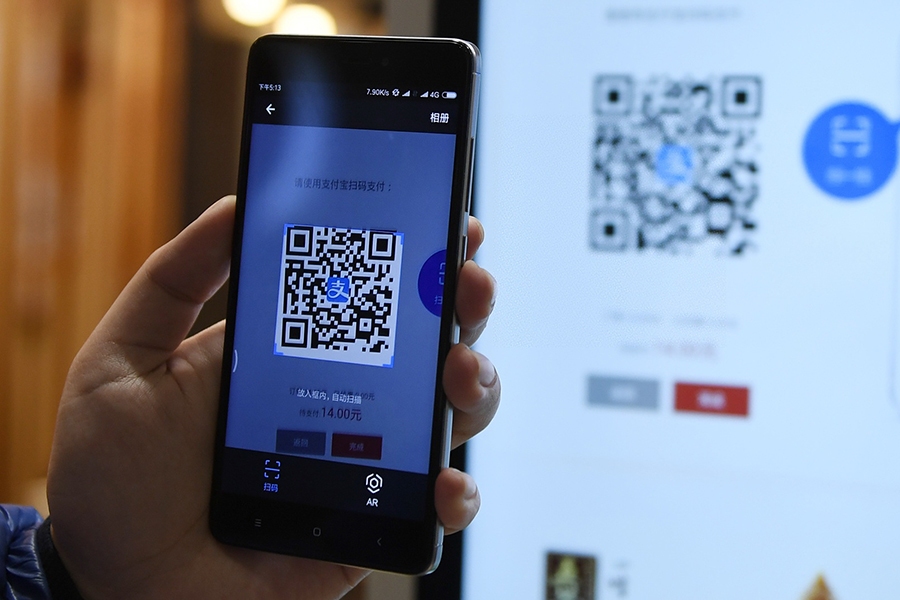
From the People's Daily app.
And this is Story in the Story.
Mobile payment is increasingly becoming the way of the world these days. It makes life so much simpler because you don’t need to carry cash or bank cards with you all the time.
Whenever you need to pay for something you can just scan with your mobile device and you’re done.
Nothing to sign, no pin to remember and no more fishing around in your wallet for cash or a credit card.
But some companies are taking it a step further by introducing face scanning. That’s right, you can pay just by having your face scanned.
That option is still new, but it could become the way of the future.
Today's Story in the Story looks at both the pros and cons of mobile payment and whether face-scanning can be a future option.

A consumer pays with Alipay after ordering food at the first self-service restaurant in Hangzhou, Zhejiang province. (Photo/Xinhua)
One of the first places to trial the new face scanning payment method is the city of Jinhua in Zhejiang.
Authorities there have introduced a new service which allows riders to pay for their bus fares through a facial scan, the local media reports.
Passengers need to register through an app provided by the bus company on their smartphone to activate the face-scanning payment system. Once registered, the onboard camera is able to verify payment through facial recognition in just one second.
The pilot service is currently active on two bus lines in Jinhua.
Bus company officials say the service will also help them with data analysis of passenger flows.
But that is not the only place where you can pay by having your face scanned.
The Chinese bakery brand Wedomé is doing the same thing. They have introduced face scanning to make it more convenient for their customers than the popular mobile payment.
According to Wedomé, the new payment option is a collaborative work with Alibaba's Alipay. With the assistance of Alipay's face-scanning function, one can face towards the camera on an electronic device set up in the bakery stores to make a payment.
Since the new payment was launched in December, it has successfully increased the efficiency of cashiers by 60 percent. Currently, there are five Wedomé bakery stores that provide this latest digital payment service.
Established in 1996, the company has opened up 300 bakery stores in Beijing, serving around 30 million customers every year. Recently, they have tried to introduce more digital elements into their daily business operations. For example, last May, they collaborated with Alibaba for the launch of the first domestic unmanned smart bakery store in Beijing that enables customers to pay through a self-service machine instead of a cashier.
"With the change of the trend in consumption upgrades, internet, artificial intelligence, and the retail industry, it [technology] has brought more convenience and richer shopping experiences,” said the founder of Wedomé Huang Li.
“The future belongs to an era of change and we must break the inherent mode of thinking and meet the new challenges," said Huang. "In 2019, one of our most important goals is to bring about change through innovation."

A girl is experiencing face-scanning payment at a Wedomé bakery store. (Photo: Global Times)
While the face scanning method of paying is on the cutting edge, most people are still coming to terms with mobile payments and most believe mobile payment will eventually replace cash.
According to a report released by Payment & Clearing Association of China, people favor mobile payment because it is a simple operation and there is no need to carry cash or bank cards.
Users mostly live in economically developed areas and population-concentrated regions such as East, North and South China. A higher number of users is found in prefecture-level cities and provincial capitals, and the proportion of mobile payment in counties and villages has increased.
In 2018, mobile payments continued to be small amounts in each transaction, with a high-frequency usage and convenient experience. "Scan to pay" has become the most popular way for mobile payment in China.
Tencent, which developed the Chinese mobile payment solution Wechat Pay, released a report in 2017 that said 40 percent of Chinese people go out with less than 100 yuan ($15.20) in cash.
"Tech companies in China have built a holistic eco-system covering financial services including third-party payments, monetary funds, insurance, online banking, credit rating, and consumer loans," the report said, adding that these tools and services would offer a better and more convenient payment experience to consumers.
However, not everyone is convinced that mobile payment is the way to go as it can be disadvantageous to some in society.
“People who don’t have a bank account and who don’t own a smartphone are not only left out by these modern ways, they are deprived of the right to shop in many places," writes New York-based author Rong Xiaoqing.
“Often high-tech products that offer convenience and equality on one level, offer inconvenience and inequality on another.”
And that, writes Rong, is something that should concern policy makers.
(Produced by Nancy Yan Xu, Brian Lowe, Lance Crayon, and Chelle Wenqian Zeng. Music by: bensound.com. Text from Global Times, China Plus, and China Daily.)


